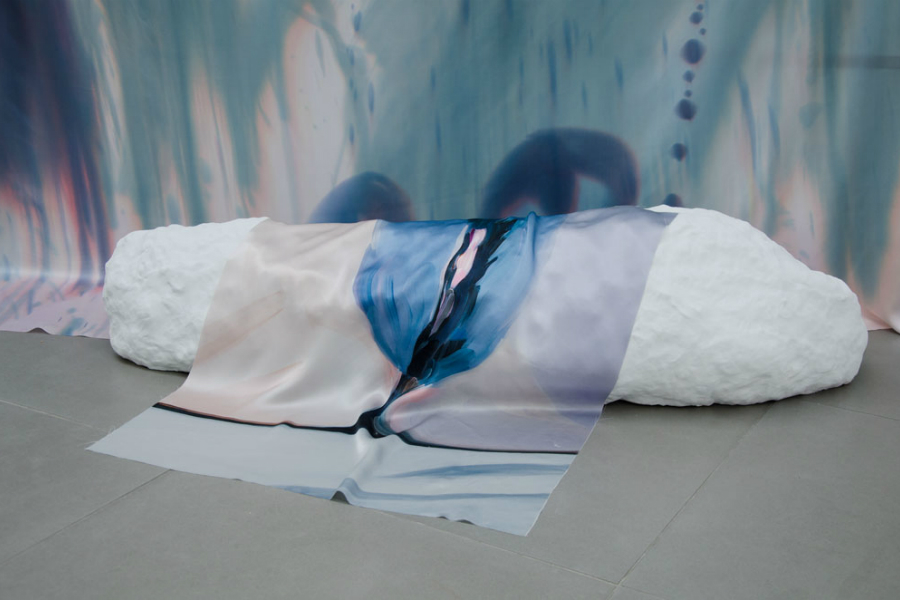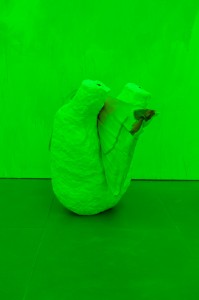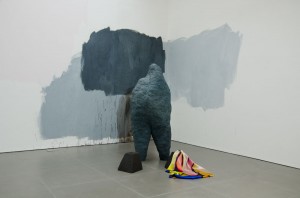In Conversation: Katie Cuddon And Celia Hempton

Curator Ceri Hand talks to Pontoon Lip artists Katie Cuddon and Celia Hempton about Rome, wobbly sculptures and sexual psychology…
Cell Project Space is a self-supporting gallery and event space based in East London, founded and directed by artists Milika Muritu and Richard Priestley. They run a great programme, offering artists at key stages of their career opportunities to make and show new work.
I have always connected with their selection of artists and was particularly interested in seeing Katie Cuddon and Celia Hempton‘s voyeuristic and tactile exhibition Pontoon Lip.
Having long had an interest in artist partnerships and collaborations, I was keen to hear how they found the process of working together…
Ceri Hand: How did the collaboration come about?
Katie Cuddon: Celia and I met because we were at the British School of Rome together (I was the Sainsbury’s Scholar in Sculpture and Drawing, and Celia was the Sainsbury’s Scholar in Painting and Drawing) so we had a year working in studios next to one another. We established a dialogue about our work then and talked about doing a show together, which we discussed more seriously about a year and a half ago.
Ceri: So you were familiar with the space before you started thinking about how you might work together, and this context was quite important?
Katie: Yes and the fact it’s a project space felt important because it was going to be a bit of an experiment…
Celia: One thing we didn’t want to do was to make a show of separate paintings and sculptures, or that would consist of many objects — as can happen in some commercial contexts. We wanted to spend time in the space together and make a show on the spot that could go anywhere and that didn’t have a fixed, finished kind of feel.
Katie: And we already spoke about work in our own particular language. We spoke in shorthand to each other about what we were doing. We didn’t have to get to know each other’s work first, the foundations were laid in Rome weren’t they?
Celia: Yes, I think because in Rome we were living in studios next to each other for a year. The kinds of conversations we had then informed this work and the collaboration. I think the level of intimacy is different when you are in a friend’s studio at night giving each other massages and talking about each others work in an un-pressured way.

Katie: It was a slow, natural process. We didn’t have any formed ideas about it to start with, they came much later once this show was set up. Because I work with clay and ceramics I needed to make work in advance of arriving in the space. So I brought semi-resolved sculptures and ideas about how they might combine with Celia’s work.
Celia: I made most of the wall paintings before Katie arrived, and she had made the sculptures, but we adjusted and edited both of these elements with each other once in the space.
Ceri: How did you go about bringing your individual ideas together? How did you know what kind of content you wanted to produce together?
Katie: We speak about that in quite an obscure abstract language.
Celia: I agree, on the whole the discussions that informed the work are abstract or about things slightly outside of the work itself. Though we also spoke about how you might look at a sculpture or a painting in terms of flatness, or how we relate to the notion of touch in our works. You were talking about how you only ever really only see a sculpture as an image rather than approaching it as a three dimensional thing…
Katie: Yes, it’s like Medardo Rosso’s idea that you approach objects from one viewpoint – as an image. A lot of his sculptures are relief-like. We were talking about giving abject things a mass or a density. You’ve in the past made landscape paintings where you would go to the periphery of cities where there was lots of detritus and lumps of redundant material and were interested in representing this matter in a solid, object-like way.
Celia: Exactly — the lumps of mud and big mounds of earth that were pushed around on building sites near North Greenwich by men in diggers.
Katie: We both work in an immediate way, but in totally different ways. You are loose and free and your surfaces are made up of sweeping painterly strokes whereas mine are quite specific and intense. We’re chalk and cheese, but meet at various places. We’ve been exploiting those differences and similarities.
Ceri: There’s a nice balance of light and darkness running through the show. Were you thinking about that balance in relation to the sexualised content on display?
Celia: Going back to our conversations about sex and our relationships — the kinds of conversations that stereotypically could be called ‘girly’ — that were very open and intimate and detailed about sexual psychology. I would say a variety of things are happening in terms of lightness and darkness in that sense. You could say there is something outwardly sharp and bold about the prints on silk, which is contradicted by something outwardly more psychologically problematic in clay.
Katie: I wanted there to be an awkwardness, an indecisiveness too, a shifting between one thing and another, a kind of unsettling, that’s what I’m always trying to do in my own work. We wanted a series of different but connected psycho-dramas taking place, but the relationships between the works are also intuited. We weren’t constructing devised narratives.

Ceri: You said you’d learned some new things working together, Katie?
Katie: Yes, it’s opened up directions for my work. Working with somebody else shows you new possibilities, it just shakes it up. I’d rather work with someone than make solo shows in the future! It’s so much more surprising… not having all the control and having things to work with and against.
Ceri: Do you feel like you both took as many risks as you wanted to? Or do you feel like you were just getting started, given you had a three-week timeframe?
Celia: In a way I have never done something that’s felt as much of a risk before! I came to the space with ingredients with which to assemble work and a completely open mind. Painting on silk is so different to painting on canvas because you can’t change it once it’s done and I don’t work like that. I see painting on silk quite like a document of a performance, in that the actions taken in that moment are there forever.
Ceri: Did you feed back to each other in terms of if you didn’t like something or thought something wasn’t successful?
Katie: Yes we are quite direct but we kind of agreed…!
Celia: It wasn’t like a big shouting match or “I fucking hate that” or “Don’t do it like this” or something; it was exciting, very trying but in a good way.
Ceri: Katie, could you say a little about how you make the sculptures?
Katie: I take a drop-scone size piece of clay and pinch it out until it’s really thin and build it up but not in a very planned or logical way, that’s why it’s so kind of wobbly, because I don’t use an armature or anything. I have an image of what I’m making, but I don’t plan it, so I don’t build a structure around it, so a lot changes, a lot happens on the way. It’s as slow a process as I can make it — a few days.
Celia: That’s where our work meets, in the touch of the person that’s making it. In my work there is machinery involved in making a print but there’s also evidence of the movement of hands and wrists. It’s the same with you. But also the palette. The colour palette for the show initially came from the Paolo Uccello painting The Battle of San Romano.
Katie: That was certainly my reference point when I was painting that work (Penumbra). That grey comes from a collapsed horse in the painting. It has a huge belly and thighs and a wonderful, voluminous bum.
Celia: Do you remember how we used to talk about horses in Rome?! There’s a lot that has been said about girls and horses and how sexualised that relationship is…
Ceri: In these works there is a sense of action and waiting, like something is about to spring into action or be active in some way, or receive something… Was that intentional?
Katie: We didn’t speak about it like that but probably…
Celia: I’m quite reluctant to say what our intentions were or exactly what we feel the work is doing as it’s so new. I’m going to need another month or more to understand what we’ve done, but that’s why it feels exciting, to do that publicly I think is quite brave.
Ceri Hand is a Curator and Arts Consultant based in London
Edited by Linda Pittwood
The exhibition, Pontoon Lip, continues at Cell Project Space, London, until Sunday 29 June 2014 – open Friday–Sunday 12-6pm, or by appointment. Free entry
Images: from top down: Roman Fountain (dimensions variable), (detail) Celia Hempton, 2014, digital print on silk satin, 60 cm x 72 cm, silk paint on silk satin, 275 cm x 290cm, acrylic paint on wall. Katie Cuddon, 2014, painted ceramic, 125 cm x 27 cm x 32 cm. Photography by Damian Jacques
Me as You, (dimensions variable), Celia Hempton, 2014, silk paint on silk satin, 73 cm x 44 cm, acrylic paint on wall. Katie Cuddon, 2014, painted ceramic, 43 cm x 30 cm x 64 cm. Photography by Damian Jacques
Penumbra (dimensions variable), (detail) Celia Hempton, 2014, digital print on silk satin, 60 cm x 72 cm, acrylic paint on wall. Katie Cuddon, 2014, variable dimensions, ceramic, 125 cm x 27 cm x 32 cm, ceramic, wax, (2x) 21 cm x 19 cm x 19 cm. Photography by Josh Wright





